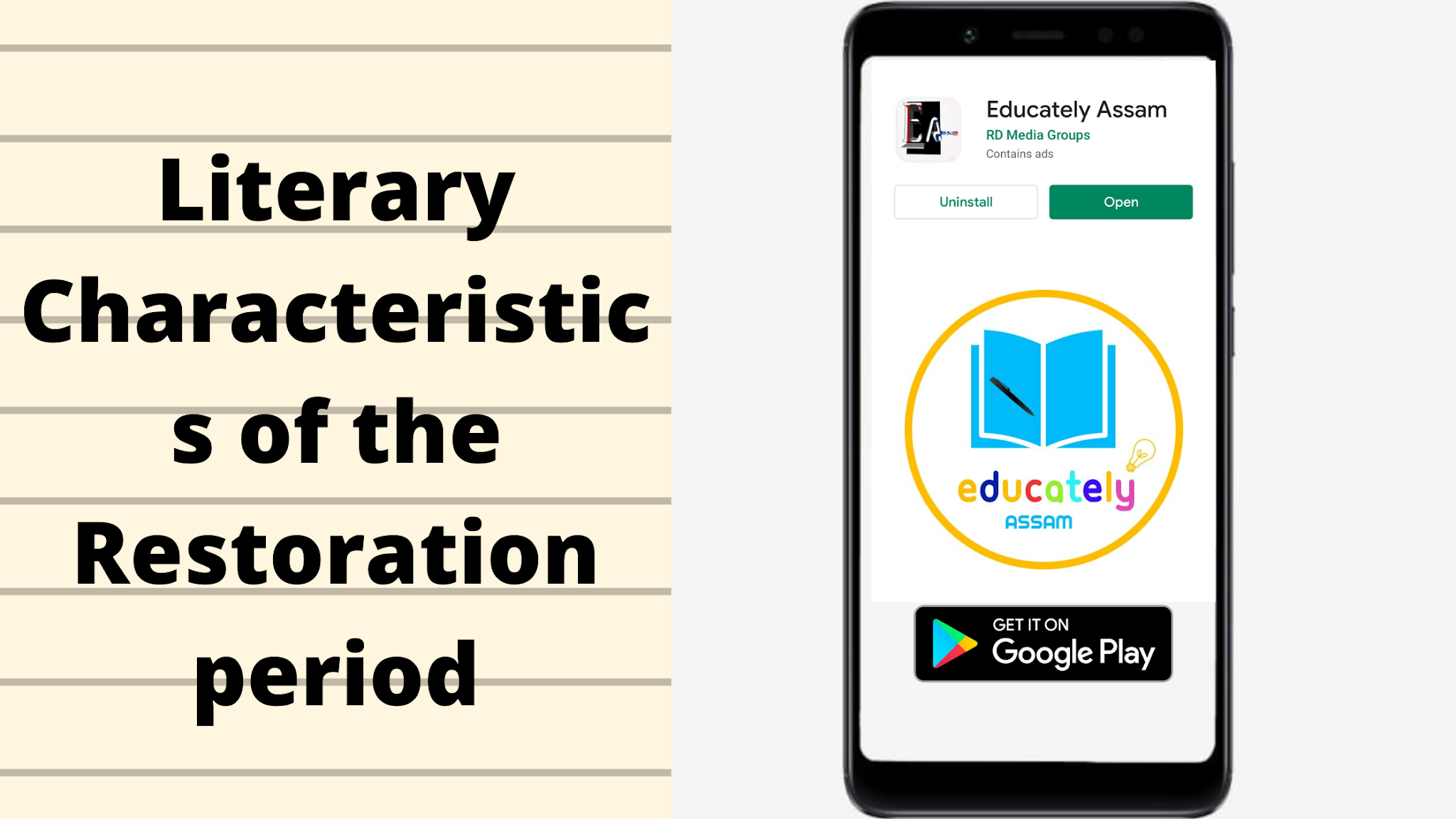Literary Characteristics of the Restoration period
 |
| Literary Characteristics of the Restoration period |
The Restoration of Monarchy in 1660 was a decisive event that had a tremendous impact on English life and literature. In fact, the two ages - The Puritans and the Restoration were utterly contradictory, and to pass from one to another was to experience a heavy shock.
In fact, the Restoration changed the character of the English people and even their tastes and manners, to some extent, but it could not revolutionize, in any unhappy manner, the essence of the English spirit in life. Amid its vulgarity and corruption, indecency, and moral looseness, the age, after the Restoration, waited for a restoration to health and sanity which took place after the bloodless Revolution of 1688.
Another literary expression of the age was perceived in the emergencies of the Satire. The conflict between political parties - the whig and the Tories - resulted in an interesting. But not always healthy, combat between literary men, supporting antithetical ideals. The genius of the English satire followed from the same and the age was known after the name of the greatest protagonist of satirical literature - John Dryden. Dryden's great satires - Absalom and Achitophel wonderful inspirations for the satiric literature of the age and immensely contributed to the development of the English satire of subsequent ages.
1. Restoration Poetry -
Satire is found to be the literary fashion of the age. Even the survivors of the Republican age, like Andrew Marvell, noted for excellent lyricism are found to have recourse to Satirical writing Marvell's later poems are satires in verse in which religious intolerance, autocratic tendencies, the lack of patriotism, and the license of the new order are delightfully scoffed at his Satire is found to have a rich sense of wit, and this makes him a quite diverting author.
The next time in satirical literature is John Oldham who is found to follow scrupulously the classical authors, like Juvenal, in his satiric writings - Satires against the virtue.
Sir Charles Sadly, John Sheffield, Shadwell, and several others are the minor satirical poets of the age. Their poetical works have little worth to deserve recognition and commendation.
In Dryden is seen the great beginning of English satirical literature, and this is found to have its wide expansion and range in the hands of swift and pope in the next century.
2. The Restoration Theatre:
In 1660 Charles II was restored to his throne with his return, drama too officially returned to England, after its official silence for long twenty-year under the authority of the puritans. The deprivation of dramatic entertainment for twenty-year did not certainly impair the appetite of the English people for this. But the plays which were presented on them were strikingly different from those of the Elizabethan age and of the early year of the Seventeenth Century. Something died out of England with the civil war. That sense of loss, profound yet intangible often, could be felt particularly in dramatists human outlook on life was no more. Drama became, to some extent pompous artificial, and to stagey. The theatre was more closely than ever the province of the court, court life, with all its affectations and vulgarity and vain-glories became the chief resources of the dramatists for their dramatic materials.
The nature of the Restoration audience was different from that of the Elizabethan age. The Restoration theatre became wholly a centre of vulgarity and low amusement for corrupt countries and rakish royalists. Consequently, there was extreme licentiousness in the dramatic works, particularly in the comedy of the age.
The theme of heroic plays was extraordinary-the adventures, made by certain heroic personalities. The theatre was packed with superhuman, melodramatic senses and bombastic expressions.
The Restoration theatre is, however, found to express its excellence chiefly in comedies. These comedies are found to have a manifold manifestation in the comedy of intrigue, the comedy of manners. Perhaps, the feelings of the people just released from the severe restriction of the Puritans could be echoed best through the witty, diverting light-hearted, comedies of the age.
Dryden again is found at the centre of the Restoration comedy, with his wild Gallant, marriage a lo mode, The Spanish Friar and the Assignation. His success is, however, nothing significant, although he displays brilliant effects in dialogue.
3. Restoration Tragedy -
Dryden is the chief architect of the Restoration tragedy. His name is particularly remarkable in the English tragedy for his all for love, written in imitation of Shakespeare's great tragedy anatomy and Cleopatra in 1677. This is a quite successful production and maybe judged fairly along with Shakespeare's masterpiece, of course, Dryden's tragedy is a much narrow range and the central action is concentrated, in the manner of heroic play of the time, a conflict between love and honour. Shakespeare's moving and orderly blank verse is exchanged for a rather rhetorical and occasionally blank verse. Still the play, despite its difference from Shakespeare great Roman play, has Shakespearean dimensions in its theme, characterisation, without any doubt Dryden's finest play and probably the greatest Restoration tragedy. But Dryden's other tragedies Amboyna (1673), the truth found too late (1679), king of Portugal (1689), and Cleomenes, The spartan hero(1692) hardly possess the same vigour or fervour. Couched in bank verse, these plays mark a return to heroic sentiments and leave no favourable impression at the end. Altogether, except the play all for Love, Dryden's attainment in the Restoration tragedy is far from satisfactory.
4. Heroic plays of the Restoration:
The heroic plays of the Restoration appears a class by itself standing between tragedy and romance. It is rather a novel form of tragedy and romance. It is rather a novel form of tragedy, so apathy represented by such continental masters, a Racine, Goethe and Schiller the subject matter of such plays are found mainly chivalrous-honour, love and war. The conflict between love and honour is tried to be depicted in a romantic setting. The entire between honour and love in a heroic personality and personalities.
As an author of heroic plays, Dryden certainly exhibited his genius and craftsmanship. He had a wonderful sense of the theatre and clear perception of the taste of the audience. All his heroic plays are built upon a set plan, with a heroic theme, concerning the conflict between love and honour, the heroic personages of superhuman prowess and ideals and intensely interesting dramatic suspense, the vehicle of expression is not the blank verse, but the heroic metre.
By the side of Dryden, there arose and ranted some other heroic dramatists, must of whom had no worth to be mentioned at all. Elknatn settle was credited with two major plays, but none of them could win a lasting appreciation. Another dramatist John Crowe proved equally unimpressive, although his play the Destruction of Jerusalem by Titus Vespasian, writer after the model of Dryden's conquest of Granada by the Spaniards had temporary popularity on the stage. Nathaniel Lee displayed the flush of heroic play with the tragedy of Nero, emperor of Rome (1674), and Sophonisba or Hannibals overthrow (1675) and Theodosius or the Force of Love (1680). Thomas Otway won reputation, next to Dryden with his two masterpiece- Alcibiades(1675) and Don Carles, Prince of Spain (1676).

.png)




No comments:
Post a Comment